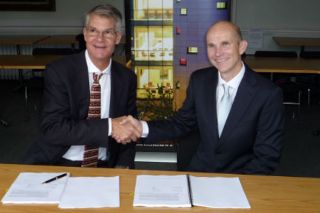Oct 27 2015
Bristol has been awarded funding to build the UK’s first NanoESCA system by the EPSRC’s Strategic Equipment Panel, including a collaboration to develop tuneable X-ray electron spectroscopy.
 Dr Neil Fox, University of Bristol, and Claes Parflo, Vice President, Global Sales of Scienta Omicron GmbH
Dr Neil Fox, University of Bristol, and Claes Parflo, Vice President, Global Sales of Scienta Omicron GmbH
The NanoESCA allows researchers to gain new insights into the properties of material surfaces at the nanoscale, with visibility down to the atomic level. This state-of-the-art system combines photo-electron emission microscopy, used to identify features of interest through changes in electronic band structure, with imaging electron spectroscopy for chemical analysis, employed to give chemical composition and structure information at the surface with sub-micron resolution. This instrument will lead to step-changing advances in renewable energy, composite materials, photonics and bio-nano research at the University.
The NanoESCA will be located in one of the two Ultra-Low Noise Labs in the University’s Centre for Nanoscience and Quantum Information, providing the flagship system for the centre. Researchers will be able to move samples between Bristol and the Diamond Light Source Synchrotron at Harwell in Oxford, using a special ‘suitcase’ that keeps the samples at ultra-high vacuum during transit, enabling them to be analysed on complementary instruments at each location.
The contract for the project will be signed by Professor Nishan Canagarajah, Pro Vice-Chancellor of Research at the University, and Dr Claes Parflo, Director of Scienta-Omicron, on Friday 23 October. The NanoESCA will be accessible to researchers in the GW4 Alliance, as well as wider research communities from academia and industry across the UK and internationally.